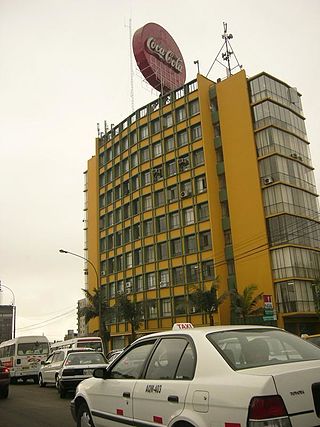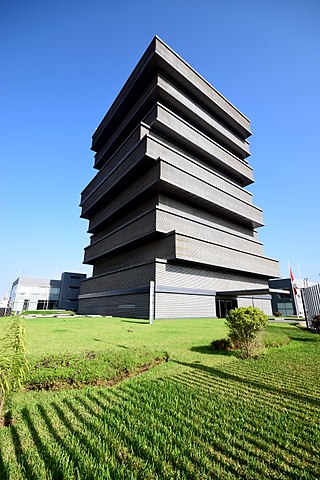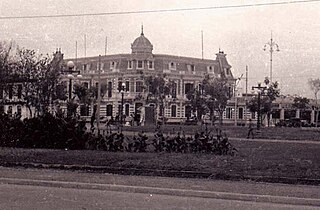The judiciary of Peru is a branch of the government of Peru that interprets and applies the laws of Peru to ensure equal justice under law and provide a mechanism for dispute resolution.

Colegio de la Inmaculada is a private Catholic primary and secondary school, located in Lima, Peru. Established by the Society of Jesus in 1878, the school finds its roots in Royal College of San Martin, founded by the Jesuits in 1582.

The Plaza San Martín is one of the most representative public spaces of the city of Lima, Peru. It is located at the ninth block of Colmena avenue, within the Historic Centre of Lima which was declared a World Heritage Site in 1988 by UNESCO. It is located near the Plaza Mayor of Lima and is connected to it by the Jiron de la Union. Its central monument gives homage to Peru's liberator, José de San Martín.
The Minister of Education of Peru is in charge of the Ministry of Education within the Council of Ministers of Peru. The building's headquarters, formerly in the Javier Alzamora Valdez Building, are now located in San Borja District. The current minister is Rosendo Serna.

The Bank of the Nation Tower is a multi-purpose building in Lima and the tallest building in Peru. It serves as the headquarters of the Bank of the Nation, after which it's named.

The Limatambo Building, also known as the Seoane Building, was a building in Lince District, Lima. The building was known for its billboards, most of which promoted the Coca-Cola Company.
Enrique Buenaventura Juan Seoane Ros was a Peruvian modernist architect of the 20th century.

University Park is a public park located in the historic centre of the city of Lima, Peru. It is rectangular in shape and is located at the intersection of Abancay and Nicolás de Piérola avenues.

Nicolás de Pierola Avenue, formerly known as Interior de Lima and La Colmena, is an avenue located in the Historic Centre of Lima, Peru. It is the southern limit of the area called Damero de Pizarro. It was founded in the year 1900.

Democracy Square is a public square in the Historic Centre of Lima, Peru. It is located on the former site of the Bank of the Nation Building, which burned down in the year 2000 during the Four Quarters March. The park's address is 1045 Nicolás de Piérola Avenue.

The Tacna-Colmena Building, also known as the La Colmena Building is a building located on the periphery of the Historic Centre of Lima, Peru. It stands at the intersection of Tacna and Nicolás de Piérola avenues, a few blocks from Plaza San Martín.

The Ministry of Education is the government ministry responsible for education in Peru.

The Petroperú Building is a building located in San Isidro District, Lima. It functions as the main office of Petroperú, a state company dedicated to refining, transporting, distributing and marketing oil in Peru.

The College of Our Lady of Guadalupe is a secular public education school in Lima, Peru. Originally founded on Chacarilla Street in the Guadalupe neighbourhood on November 14, 1840, it moved in 1909 to its current location on Alfonso Ugarte Avenue, built during the government of Augusto B. Leguía.

Jirón Apurímac is a street in the Damero de Pizarro, located in the historic centre of Lima, Peru. The street starts at its intersection with Abancay Avenue, behind the Javier Alzamora Valdez Building, and continues until it reaches Jirón Carabaya.

Abancay Avenue, formerly known as Jirón Abancay, is a major avenue that serves as the limit between the Damero de Pizarro and Barrios Altos, both located in the historic centre of Lima, Peru. The street starts at the Ricardo Palma Bridge and continues until it reaches Grau Avenue.

The Building of the Ministry of Finance and Commerce is one of the largest buildings located in Abancay Avenue in the historic centre of Lima. Surrounded by Santa Rosa, Cuzco and Ayacucho streets, it serves as the headquarters of the Public Ministry of Peru.

The Casa Tenaud, also known as the Palacio Tenaud or as the Palacete Tenaud, was a building located at the intersection of today's Grau Avenue and the Paseo de la República, in Lima, Peru. The building was burned down on December 7, 1945, due to it being the location of the offices of the Revolutionary Union political party, including that of its leader, Luis A. Flores.
Walter Weberhofer Quintana was a Peruvian architect of the 20th century.

The Banco Comercial was a multi-purpose office building located in the historic centre of Lima, Peru. It housed the Banco Comercial del Perú (BANCOPER), after which it was named, and later the Banco de la Nación. The building was designed by Peruvian architect Enrique Seoane Ros, and built by Flores & Costa, S.A., a Peruvian construction firm.


















